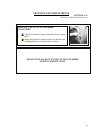
49
SETTINGS AND ADJUSTMENTS
SECTION 4-14
Adjusting or Replacing Rotor Knives
TIGHTEN THE ROTOR KNIVES TO FINAL TORQUE
Use a 30 mm socket wrench to tighten the mounting
screws on each knife in small steps keeping them about
even as you increase the torque on them.
Use a torque wrench to apply the final torque of 472 ft
lbs (640 Nm) to the mounting screws. Make sure your
footing is secure before you apply the final torque.
Check with a 0.0015" (0.04 mm) feeler gage to ensure
that each knife is snug against the knife seat.
CHECK THE BED KNIVES
If the bed knives have been removed, check them as follows:
Check both halves of the upstroke knife (the bed knife on the far side of the rotor) to be sure
that the cutting edges face down.
Check both halves of the down-stroke knife (the bed knife on the near side of the rotor) to
be sure that the cutting edges face up.
GAP ADJUSTMENT TIPS
It is best to keep the adjustments on the captive screws moving in the same direction. This
eliminates the effect of backlash in the adjusting screw.
Make the screw adjustments in small steps to keep the bed knife adjustment even over the
width of the machine.
To avoid cutting the shim stock, turn the rotor backward during the adjustment procedure.
Use the rotor knife with the largest dimension from rotor centerline as the reference, i.e., the
highest knife.
MEASURE THE KNIFE GAP
Use brass shim stock to set the knife gap to the cutting
clearance of 0.006 in. to 0.008 in. (0.15 mm to 0.20 mm).
Remove the rotor-locating pin.
Rotate the rotor backward, by hand, and measure the gap
between it and the bed knife at the point of shear. You
can work on each half of the bed knife independent of the
other half but keep them in step with each other by
working from side-to-side.


















